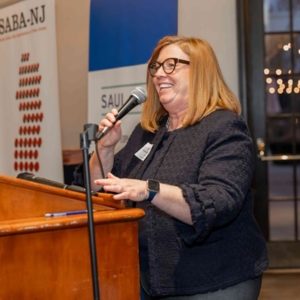Video Startups, History of Digital Media Players at May NJ Tech Meetup
When NJ Tech Meetup held its most recent gathering on May 21, 2012, N.J. companies were front and center. The featured speaker was Guy Story, CTO at Audible, located in Newark though technically now part of Amazon.com.
Two of the three startups presenting — Vidoovy and EnHatch — also come from the Garden State. That’s not always the case: NJ Tech Meetup often hosts companies and speakers from New York.
Founded by Aaron Price, a startup entrepreneur at crafterMania and entrepreneur at large for DFJ Gotham Ventures (New York), NJ Tech Meetup is the state’s largest tech meetup group, now numbering more than 1,800.
At any given meeting, 150 entrepreneurs, developers and other tech ecosystem members mingle, network and exchange ideas on the Stevens Institute of Technology (Hoboken) campus, overlooking a beautiful New York skyline. It’s never the same old thing at the meetings; often about 40 percent of those attending have never been to a meetup before, so there are always new people.
The evening’s audience choice winner was Lyndhurst-based EnHatch, which delivers 3-D modeling and computer animation of medical device technology to device manufacturers, who pass it along to surgeons — the definitive sales app, the company says. For device manufacturers, it’s important to make surgeons happy, founder Peter Verrillo stated.
EnHatch has found a way to make the videos and animation inexpensively so they can be displayed on iPads. The result: a vivid, clear view of the medical device and how it fits into the whole picture.
While the medical device manufacturing vertical is very lucrative, the company is at a crossroads: “Should we spend money on a sales force and focus on the medical device vertical?” Verrillo asked, or should the company grow horizontally, exploring using the 3-D platform to show, for example, how to assemble furniture Ikea-style?
Another N.J. company, Direct Ignition, pitched its hyperlocal video site, Vidoovy, aimed at communities. The West Orange-based startup, whose tagline is “Where Communities Strut Their Stuff,” wants to find “a technological solution to bring health back to Main Street,” cofounder Patrick Sutherland said. It is working with local municipalities to create a map of town “assets,” using a mashup with Google places.
Using videographers, the company then makes videos of local shops and service companies that deliver craftsmanship and customer service; adds videos of municipal parks, schools and other points of interest; and places icons for them on a community map. Each icon points to a web video. Vidoovy’s goal: to bring 5 percent of the business lost to big-box stores back to local shops. The Vidoovy product is currently in beta with the N.J. township of West Orange, Sutherland said, and plans to create mobile apps for each community with which it is working.
Also presenting was Devi’s Closet, a New York-based website founded by Meera Patel and her friend Sheena Patel, two self-described fashionistas who’d had trouble finding a way to buy or rent luxury clothing for South Asian weddings. Presenter Meera Patel explained that these weddings can last several days, but most attendees don’t want to wear the same outfit more than once. Their solution: an online resource where designer creations can be rented.
During the main event, Audible’s Guy Story presented “A short history of portable media as told from the perspective of the company that launched the first media player for the Internet,” and he didn’t disappoint.
Audible’s founders invented the first digital media player — a precursor to MP3 players — in Wayne, N.J. It came with a whopping 4 megabytes of memory. The mobile player had an FM transmitter and was dedicated to the spoken word. A plus: users could navigate the device in their cars while keeping their eyes on the road, Story said.
Alas, Audible “didn’t sell a whole lot of these. We were a little company, and nobody knew who we were,” Story explained. A better strategy, they had thought, would be to cooperate with device manufacturers to get Audible content into those devices. In the end, he noted, it was all about the content.
Story spoke about his company’s journey through many digital media player iterations. Audible supplied the book technology platform for them all; however, it wasn’t easy.
Each manufacturer used a different processor. There were different audio compression codecs to worry about — including one that aimed at making compressed music sound like the original (called “psychoacoustic”) and another from the telecom world that compressed words in a way to keep them intelligible. Of course, “it turned out the telephony guys wound up with a different set of specs than the psychoacoustic guys,” Story noted.
Different operating systems entered into the mix. Further, the differences between songs, which are short, and books, which are very long, came into play in designing files and controls. “In order for devices to play books from Audible, they had to be able to remember where you were in a book, because you’d go insane on Day Two if you couldn’t” resume reading where you had left off.
The company also had digital rights management to deal with. “At the time Audible started, we could not do a single content deal without promising we would keep the content from being shared among our customers,” Story explained.
Story said cloud computing is bringing forth a new golden age, ending the days of “one-off systems development.” This should help improve users’ experience with services, he concluded.


